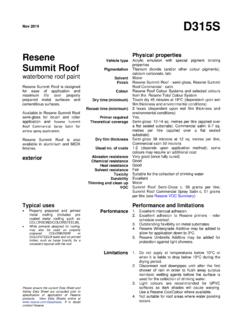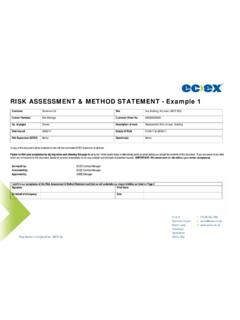Transcription of Natural roofing slate design and fixing guide
1 CI/SfB(47)Ne5 May 1999 Natural roofing slate design and fixing guideSSQ 44pg for PDFing 1/3/01 1:55 pm Page 1 Nail fixing method4 design considerations4 Environmental conditions4 Pitch of roof5 Minimum laps6 Batten sizes6 Underlay6 Ventilation requirements6 fixing methods6 Types of nails6 7 Coverage of slatesApplication details8 Eaves9 Verges10 11 Ridges12 13 Hips14 15 Valleys16 17 Abutments/parapets18 19 Change of roof pitch/Mansards20 21 Vertical cladding22 SiteworkHook fixing method24 design considerations24 Environmental conditions24 Pitch of roof25 Minimum laps26 Batten sizes26 Underlay26 Ventilation requirements26 fixing methods26 Types of nails26 27 Coverage of slatesApplication details28 Eaves29 Verges30 31 Ridges32 33 Hips34 35 Valleys36 37 Abutments/parapets38 39 Change of roof pitch/Mansards40 41 Vertical cladding42 SiteworkThis guide has been prepared by the SSQ Group incollaboration with practising UK architects, familiarwith both traditional (nail)
2 And hook fixing is intended to provide comprehensive informationon the design and fixing of SSQ Natural slate roofingand cladding products. Product literature on theseproducts, including Del Carmen, Caborco and Rocaberslates, is available on request from advise and assistance on the design , application,installation and specification of SSQ slates, at anytime, please contact the SSQ Technical ServicesDepartment on:tel 0208 961 7725fax 0208 965 and organisations referred to in this guide :BS 680: Part 2: 1971, Metric unitsBS 747: 1994, Specification for roofing feltsBS 1202: Parts 2 and 3: 1974 BS 5250: 1989 (1995), Code of practice for controlof condensation in buildingsBS 5534: 1997, Code of practice for slating andtiling, Part 1: DesignBS 6399: Part 2: 1997, Code of practice for wind loads BS 8000: 1990 (1997), Workmanship on buildingsites, Part 6: Code of practice for slating and tiling ofroofs and cladding. BS 8104: 1992, Code of practice for assessing exposureof walls to wind-driven rainBRE Report, Thermal insulation: avoiding risksBRE Digest 346: Parts 1 to 7BS 747: 1977 (1986)Building Regulations F2: 1995 BS 1202: Parts 2 and 3: 1974 Lead Development Association34 Berkeley Square London, WX1 6 AJTelephone 0207 499 8422 ContentsNail fixing4 TELEPHONE0208 961 7725 design considerationsEffective design of a slate roof must take into accounta number of inter-related factors including siteexposure, the pitch of the roof, the type of slateselected and the slate guidance on the most important points to beconsidered is given below.
3 Full application andsitework details are given on pages 8 to 22. Furtherinformation can be obtained from BS 5534: 1997,Code of practice for slating and tiling, Part 1: design . Reference should be made also to BS 8000: 1990(1997), Workmanship on building sites, Part 6: Codeof practice for slating and tiling of roofs and conditionsa Rain exposureThe degree of exposure of a building to driving raindetermines the minimum lap which should be anticipated degree of exposure is given in Figure 1(taken from BS 5534: Part 1: 1997).Localised factors such as high buildings, buildings onthe slopes or tops of the hills and coastal sites, canincrease the exposure grading which should be appliedin a specific project. Table 1 on page 5 shows therecommended minimum lap for moderate and severeexposure more detailed information on exposure to rainrefer to BS 8104: Wind upliftAdequate resistance to wind load and wind lift can beprovided by following the application details shown onpages 8 to 21, taking into account minimum laprecommendations given in Table calculations for wind load and wind uplift aregiven in BS 5534: Part 1, BRE Digest 346: Parts 1 to7 and BS 6399: Part 2: 1990, Code of practice forwind loads, which replaces BS CP3: Chapter 5: Part2: of roofIn general, the lower the pitch of the roof, the greatershould be the lap.
4 This longer lap will help to resistboth capillary action and wind steeper pitches with free-flowing drainage, smallerslates may be exposed sites, wide slates with a greater lapshould be used (see Clause 18 of BS 5534).LapThe lap is calculated by taking account of wind uplift,exposure to driving rain and the roof pitch. Table 1gives the recommended minimum laps for various roofpitches and building 1 Categories of exposure to driving rainexposurezonesDesign workapproximate wind drivenrain (I/m2per spell)less than to or greater than design and fixing guideNail fixing TELEPHONE0208 961 77255 Table 1 Minimum recommended laps in mm for different exposures and roof pitchesModerate exposure index between 3m2/s and 7m2/sSlate size (mm) Roof pitchlength width85 45 40 35 30 25 221/2 20 600 3006565757590105125500 300656575759090115500 250506565757590105120450 300506565757590100120450 250506565757595110125450 2305065657575100115130400 3005065657575400 2505065657575400 2005065657575350 3005065657575350 2505065657575350 2005065657575 Severe exposure index greater than 7m2/s slate size (mm)
5 Roof pitchlength width85 45 40 35 30 25 221/2 20 600 300657585105115135150500 30065757580100500 2506565758595110450 30065657595100115450 250656590105110125450 230656595110115125400 3006565758085400 2506565759095400 200656590100105350 3006565757575350 2506565757580350 20065657585906 TELEPHONE0208 961 7725 BattensRecommended timber batten sizes for Natural slateroofs are 50 25 mm, up to 600 mm rafter spans,according to BS 5534: Part 1: should be set out horizontally across the roofat a gauge calculated from the formula:gauge =(length of slate lap)2 Battens should be nailed at maximum 600 mmcentres, with the end of each length fully supportedand be not less than 50 mm wide by 25 mm used, counterbattens should be a minimum38 12 should be selected to meet the requirementsof Clause 13 of BS 5534: Part 1: 1997. Where theunderlay is not fully supported, it should be Type 1 Freinforced bitumen felt to BS 747: 1994 or otherapproved material of adequate strength and comply with the Building Regulations F2: 1995and BS 5250: 1989 (1995), Code of practice forcontrol of condensation in buildings, ventilationequivalent to a 10 mm continuous vent must beprovided at the eaves on both sides of the roof whenthe roof is of cold roof construction and 25 mm if of warm roof ventilation at or near the ridge equivalentto a 5 mm continuous vent is required in the case of warm roofs and is also recommended if the case of cold roofs if pitch of the roof is greater than 35 , orif the span is greater than 10 metres.
6 Cold roofs are defined as being those where theinsulation is at ceiling level, and warm roofs wherethe insulation is in the plane of the roof (rafter level). fixing methodsAll SSQ Natural slates can be fixed by using eithertraditional holing and nailing (see pages 8 to 22) orthe hook fixing system (see pages 28 to 42).NailsNails should be either aluminium alloy to BS 1202: Part3: 1974 or copper to Part 2: 1974, or stainless should be 20 to 25 mm longer than twothicknesses of slate , but longer nails should be used atthe eaves course especially if a sprocket is of slatesSee table 2 for coverage of all slate sizes at weight of slate roofThe total weight of slates on a roof can be calculatedas follows:ExampleSlate typeDel CarmenSlate size (mm mm)400 250 Weight of slates (kg/1000)1235 ExposureModerateRoof pitch40 Roof area m2150 Length of roof slope (m) headlapcan be found from Table 1 by reference toslate size, roof pitch, and exposure = 65 slate coverageper m2can be found from Table 2= total weightof slates on roof can be found fromthe formula.
7 Weight of slates (kg) area of roof (m2) slate coverage1000 Therefore, the total weight=1235/1000 150 4427 kgSSQ design and fixing guideNail fixing TELEPHONE0208 961 77257 Table 2 Coverage of SSQ slates with nail fixing method slate size (mm)Lap (mm)length width5065758090100110115120130140150 Number of slates/m2600 allowance has been made for wastage Figure 2 Cold and warm roof ventilationCold roofinsulation at ceiling joist levelWarm roofinsulation at rafter level8 TELEPHONE0208 961 7725 EavesAt all eaves, a double course of slates is required,comprising a course of short slates over which the firstcourse of full length slates is length of the eaves slates should be gauge + sequence at eaves1 Fix the underlay to extend over the tilting fillet andfascia board into the gutter. The underlay shouldoverhang the fascia board by 50 Fix the first full course batten (the eaves batten) so that the tails of the slates in the eaves and theundereaves courses align, ensuring that they willoverhang 40 to 50 mm into the gutter.
8 Fix theundereaves batten immediately below the eavesbatten (see page 6 for minimum batten dimensions).3 Lay the slates forming the undercourse on theirbacks and head-nail them to the undereaves Fix the eaves course with the tails of the slatesaligning with the tails of slates in the design and fixing guideNail fixing TELEPHONE0208 961 77259 VergesWhere an undercloak is fixed it should consist of oneor more courses of slates not less than mm thick,laid riven side up and closely more than one course is used, joints should should be finished with slate and slate -and-a-half in alternate courses. Provision may be made for aslight inward tilt from the verge. Mortar for bedding and pointing; 1:3 cement/sandpigmented to match colour of sequence at verge on brickwork1 Bed the undercloak in mortar so that it extends 40 to 50 mm from the face of the Fix verge slates flush with the Fill the gap between the undercloak and the slateswith mortar and strike off smoothly to provide aflush sequence at verge on bargeboard1 Fix the undercloak with nails so that it overhangsthe face of the bargeboard by 40 to 50 Fill the gap between the undercloak and slates with mortar and strike off smoothly to provide aflush 961 7725 RidgesThe length and gauge of slate in the top courses at theridge must be sufficient to ensure that the appropriatelap is slates should be used in the course belowthe top course to enable the short top course slates tobe nailed directly to the sequence with tiled ridge1 Fix underlay over the ridge so that it overlaps themain underlay by at least 150 mm.
9 When usingventilated ridges, a gap of 50 mm should be allowedbetween the top of the underlay of each Fix the top course of slates to maintain Lay ridge tiles true. Joint ridge tiles in mortar andfirmly bed the edges along the roof slope in ridge tiles meet, squeeze up the bedding tofill the joint and strike it off smoothly; no separatepointing is Fill the ends of the ridges at the gables with mortarand slips of slate finished flush with the sequence with sheet metal ridge (not illustrated)If required, stainless steel, copper or zinc ridges canbe made by the roofer on Fix 150 mm wide board in lieu of battens at Fix underlay over the ridge so that it overlaps themain underlay by at least 150 mm. When usingventilated ridges, a gap of 50 mm should be allowedbetween the top of the underlay of each Fix the top course of slates to maintain Fix 50 mm zinc tack at 500 mm Fix the sheet metal ridges on the board,overlapping each ridge piece by 100 mm andnailing it to the board with two clout nails on eachpitch wherever an overlapping end of the ridge withpre-bonded clips.
10 At verges, hips etc., cut andshape the ridge ensure resistance to wind pull-out, the lengthof the ridge pieces should not exceed 1 sequence with lead roll ridge1 Fix underlay over the ridge so that it overlaps themain underlay by at least 150 mm. When usingventilated ridges, a gap of 50 mm should be allowedbetween the top of the underlay of each Fix the top course of slates to maintain Cover the timber roll with Code 6 lead strips 450 to500 mm wide and to m long. Lap the strips75 mm at the joints; secure the lead with screws;top sealed with a lead dot under the overlap. Fix 50 mm lead tacks at 750 design and fixing guideNail fixing TELEPHONE0208 961 77251112 TELEPHONE0208 961 7725 HipsIn cutting slates for hips, care must be taken to preservean adequate bond, using slate and a half pitches at hips are almost vertical, the hips canbe treated in the same way as sequence at mitred hip1 Fix 600 mm wide underlay, overlapping the Cut slates carefully, ensuring that adequate width ismaintained at the head.








